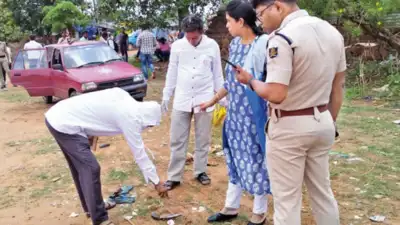Trigger Point: Odisha Police intensifies ‘non-fatal’ shootout strategy to combat rising crime | Bhubaneswar News

Over the past few months, the state has seen a rise in criminals with guns targeting police and civilians. This is also resulting in more shootouts, as police fight fire with fire, in self-defence.
TOI
looks at some recent cases
It was the dead of the night. Police personnel quietly took positions at Balianta on the outskirts of Bhubaneswar at 2 am on Feb 17. Suddenly the quiet atmosphere was shattered by the sounds of gunshots. As dawn broke, it came to light that Arjun Anare (30), a habitual criminal from Dhar district of Madhya Pradesh, had been arrested after a ‘non-fatal’ encounter. Anare allegedly fired first at police, leading to him receiving a bullet injury below his left leg in retaliatory action.
While many may view it as a standard police operation, it signalled the beginning of an intensified ‘shoot to stop’ strategy implemented by the police. Although similar shootouts had occurred in the past, they were few and far between.
Though no official documentation of shootouts exists (police only compile data of Maoist encounters), Odisha police sources said only 5 and 3 ‘non-fatal’ encounters took place in the state in 2023 and 2024. However, the period between Feb 17 and April 25 this year has witnessed 13 exchanges of gunfire between police and criminals across various districts. The operations have led to 19 criminals receiving gunshot injuries and 21 arrests.
Precise operations
Precise targeting and careful execution of the operations represents a balanced attempt to maintain law and order while avoiding loss of life. “Our primary objective is to neutralise criminal activities while ensuring minimal casualties. The ‘non-fatal’ encounter strategy allows us to achieve both goals effectively,” an SP said.
‘Non-fatal encounter’ policy marks a significant shift from traditional methods of dealing with hardened criminals. The operations, typically conducted between 2 am and 3 am, share a distinctive characteristic — pre-dawn timing to minimise civilian presence and reduce collateral damage, clear warning before engagement, targeted shooting at lower extremities, immediate medical attention for injured suspects, thorough documentation of each incident and criminal profile as well as recovery.
Bhubaneswar has been a focal point of these operations, with seven arrests following shootouts on Feb 17, March 9, April 3 and April 11. Similar operations have been conducted in Sambalpur, Angul, Rourkela, Jharsuguda and Cuttack, demonstrating a coordinated statewide effort to combat criminal activities. The intensified crackdown aligns with the state govt’s zero-tolerance stance against crime.
CM Mohan Charan Majhi’s recent meeting with senior police officers set the tone for the aggressive approach. Following the meeting, DGP Y B Khurania reportedly conducted video conferences with SPs and DCPs, issuing clear directives to deal with criminals with an iron hand. Though the DGP recently clarified that no such ‘encounter drive’ order was issued, police sources said SPs were given a free hand to rein in criminals.
“We do not look for encounters,” said a police officer. “But we have been advised not to spare criminals if they fire at us first. We have been advised to retaliate with utmost restraint.”
A senior police officer, speaking on the condition of anonymity, emphasised the meticulous planning behind each operation. “We first issue a clear warning before engaging,” the officer said. “In each case, suspects fired first, compelling our officers to respond defensively.”
Officers undergo rigorous training sessions that include precise shooting techniques, decision-making under pressure, medical first response training, tactical movement and positioning, challenges and considerations amid risk of retaliatory actions from criminal groups.
Commissioner of police S Dev Datta Singh said all the encounters in Bhubaneswar and Cuttack occurred when they intensified their crackdown against criminal activities. “Criminals are resisting when police step up action against them. Criminals are creating such a situation that police have to resort to retaliatory firing for self defence,” Singh said.
Police officers claimed the success of the operations has disrupted organised crime networks, led to recovery of stolen property, increased deterrence against criminal activities, and improved public safety perception. “We’re sending a strong message to the criminal world,” another officer said.
















